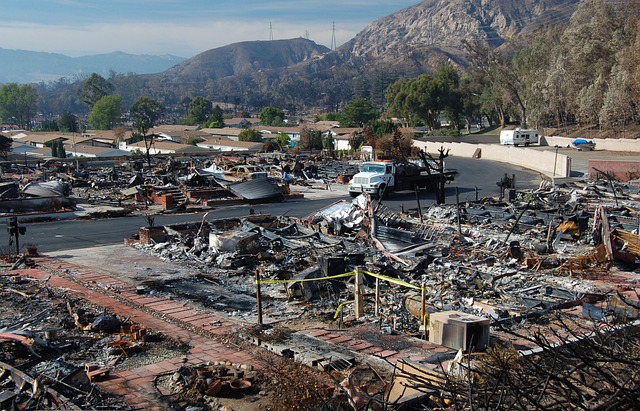When selling a house with fire damage in California, proper water damage mitigation is critical. Homeowners should assess visible and hidden dangers like mold, structural issues, and compromised electrical systems, and promptly initiate cleanup and repairs within 24-48 hours to minimize losses. Professional restoration services use advanced techniques for effective drying, ensuring property safety and preserving resale value. Transparency about water damage history is legally mandated and essential to avoid fraud charges, penalties, and delays in the competitive California real estate market.
Water damage mitigation is a critical process that requires immediate attention, especially in high-risk areas like California. This comprehensive guide delves into essential aspects of water damage management, from understanding its causes and assessing extent to emergency response and restoration techniques.
For California real estate buyers and sellers, fire damage and water considerations are paramount. Learn how to navigate the legal and financial complexities when selling a house with water damage history, crucial steps to ensure a smooth transaction in this competitive market.
- Understanding Water Damage Mitigation: A Comprehensive Guide
- Fire Damage and Water Considerations in California Real Estate
- Assessing Water Damage: What to Look For in a Home Inspection
- Emergency Response: The First 24-48 Hours After Water Damage
- Dry Out and Restoration: Techniques for Effective Water Mitigation
- Legal and Financial Aspects: Selling a House with Water Damage History
Understanding Water Damage Mitigation: A Comprehensive Guide

Water damage mitigation is a crucial process, especially when preparing to sell a house with fire damage in California. It involves a comprehensive approach to assess, contain, and restore affected areas to their pre-loss condition. This guide aims to equip homeowners and real estate professionals with essential knowledge for effective water damage remediation.
By understanding the scope of water damage, from visible signs like mold growth and structural deformities to hidden issues such as compromised electrical systems and drywall deterioration, you can initiate a thorough cleanup and repair process. In California’s real estate market, where fire damage is a common occurrence, prompt action is key. Efficient mitigation strategies not only enhance the property’s value but also ensure a smoother selling experience.
Fire Damage and Water Considerations in California Real Estate

When selling a house with fire damage in California, understanding water considerations is paramount. Fire and water often go hand in hand during a blaze, leading to secondary damage like smoke stains, odours, and moisture intrusion. In California’s diverse climate, where wildfires are prevalent, real estate agents and homeowners must be aware of these interconnected issues.
Water damage mitigation becomes crucial after a fire because it can affect the structural integrity and overall value of the property. The state’s strict building codes and environmental regulations further complicate the process of repairing and selling homes with such damage. Homeowners should consult with professionals who specialize in both fire restoration and water damage remediation to ensure a thorough assessment, effective treatment, and compliance with local laws, thereby increasing the chances of successfully selling their property.
Assessing Water Damage: What to Look For in a Home Inspection

When assessing water damage, especially in California where home sales often involve older properties prone to plumbing issues, it’s crucial to look beyond visible signs. A thorough home inspection should include checking for potential sources of water intrusion, such as cracks in foundations or walls, loose tiles, and faulty pipes. Look for signs of mold growth, which can indicate hidden water damage, as this could significantly impact the health of future occupants.
In addition, inspect areas that are often overlooked but prone to moisture build-up, like attics, basements, and crawl spaces. Check for water stains on ceilings, walls, or floors, as these may signal structural damage caused by prolonged water exposure. During the inspection, pay close attention to musty odors, which can be an early warning sign of mold growth, a concern when selling a house with fire damage in California due to the increased risk of structural instability and hidden issues.
Emergency Response: The First 24-48 Hours After Water Damage

In the critical 24-48 hours after water damage, an immediate emergency response is crucial for mitigating potential losses in a property, especially when preparing to sell a house with fire damage California. The initial steps involve turning off the main water supply to prevent further influx of water and ensuring the safety of occupants by evacuating the area if necessary. Documenting the damage through photos and videos is essential for insurance claims.
During this period, it’s vital to remove damaged materials such as drywall or furniture to prevent mold growth and structural decay. Professional restoration services should be contacted promptly to assess and begin restoration processes like drying, cleaning, and decontaminating the affected areas. These actions are critical not just for repairing water damage but also for ensuring a safe environment and preserving the property’s resale value when selling a house with fire damage California.
Dry Out and Restoration: Techniques for Effective Water Mitigation

After initial water extraction, the next crucial step in water damage mitigation is drying and restoring affected areas. This process involves advanced techniques to ensure effective removal of moisture, which is essential when preparing a house for sale after fire damage in California. Professional restoration companies utilize sophisticated equipment like dehumidifiers, air movers, and thermal imaging cameras to locate hidden moisture sources.
These tools help dry out structures quickly, reducing the risk of mold growth and structural damage. Proper drying also prevents further deterioration of personal belongings and fixtures. Once the area is thoroughly dried, restoration work can commence, ensuring that the property is not only safe but also meets high standards for potential homebuyers, even after experiencing fire damage.
Legal and Financial Aspects: Selling a House with Water Damage History

When putting a home up for sale, especially in California, it’s crucial to be transparent about any history of water damage. Failure to disclose could lead to legal repercussions and financial losses for the seller and buyer alike. In California, real estate transactions are governed by specific laws that require sellers to reveal known material defects, including water damage, to potential buyers. Concealing such issues may result in fraud charges and significant monetary penalties.
The financial implications extend beyond legal consequences. Buyers often conduct home inspections as part of the buying process. If hidden water damage is discovered during an inspection, the buyer may choose to terminate the sale, demanding a refund of their deposit. Alternatively, they could proceed with the purchase but negotiate repairs or reduce the selling price to account for the damage, impacting both the seller’s profits and the overall sales timeline.
Water damage mitigation is a complex process that requires a multi-faceted approach, from initial assessment to legal considerations. As highlighted in this article, understanding the nuances of each step—from emergency response to restoration and financial implications—is crucial for both homeowners and real estate professionals in California. When selling a house with fire damage history, proper water damage mitigation ensures not only the safety and health of future occupants but also maximizes property value. By adhering to best practices and seeking professional assistance, it’s possible to navigate these challenges successfully.






